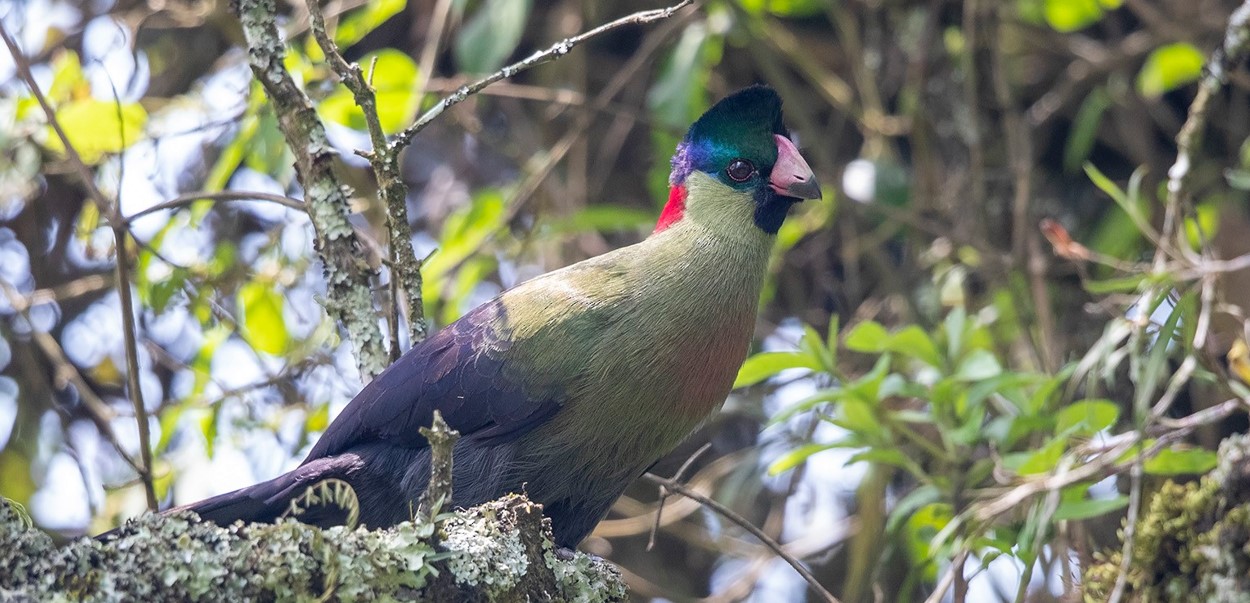
The Vibrant Rwenzori Turaco of Uganda
The vibrant Rwenzori Turaco of Uganda is a wonder to behold for both birdwatchers and nature lovers. This bird is as mysterious as the misty highlands that it calls home. This bird species, scientifically named Gallirex johnstoni, is found in Uganda’s lush montane forests of the Mountains, an area rich in biodiversity.
The Rwenzori Turaco, with its vibrant plumage that is predominantly green with a stunning scarlet crest and wingtips, is not just another bird; it is a representation of the distinct environment of the Albertine Rift. The majority of the turaco’s food consists of fruits, particularly figs, which it consumes in its high-altitude habitat, which is between 2,000 and 3,000 metres above sea level.
Known as the “Mountains of the Moon,” the Rwenzori Mountains provide more than just a refuge for turacos. They offer a world of wonder to scientists and explorers alike, with nine lake valleys, towering glaciers, and a diverse array of flora and wildlife that shift as one ascends through various vegetation zones. Visitors can immerse themselves in this ethereal setting and perhaps even get a glimpse of the rare turaco by using the trekking services available in the area.
Conservation Status of the vibrant Rwenzori Turaco of Uganda
Since environmental changes pose a threat to the Rwenzori Turaco’s habitat, conservation activities are essential to the species’ continued existence. Thankfully, the IUCN has classified it as a species of least concern, suggesting a stable population. This designation shouldn’t, however, cause complacency because maintaining the Rwenzori Turaco also protects the mountains and the wide variety of biological species they sustain.
A living example of Uganda’s ecological treasures and the significance of conservation, the Rwenzori Turaco is more than just a bird. It serves as a reminder that biodiversity and aesthetics are interdependent and that protecting one will safeguard the other. For those who have seen turacos in their native environment, seeing them in their natural habitat is a spiritual experience that resonates with the soul, a vivid memory of nature’s splendour that endures long after the mountain trek is over.
What is the best time to spot the vibrant Rwenzori Turaco of Uganda?
Seeing the colourful Rwenzori Turaco bird species in its environment can be an amazing experience. It is indigenous to the Afro-montane forest areas. It is better to travel during the dry months, which are generally June to October and December to February, for the best chance of seeing this rare species. The skies are clearer during these times, making for great bird-watching visibility. There is typically less precipitation to cause problems on your walk across the mountains, and the weather is more steady overall. While these are the best months to observe, it’s important to remember that sightings of the Rwenzori Turaco are never assured because, like all wildlife, they can be unpredictable. However, scheduling your trip around these suggested periods raises the possibility of a successful birding adventure. For further information on planning your trip, consider reaching out to Journeys Uganda, which specialises in bird-watching tours.
Where can I find the vibrant Rwenzori Turaco of Uganda in Uganda?
Bright and colourful, the Rwenzori Turaco is indigenous to the alpine forests of the Albertine Rift. The Rwenzori Mountains National Park is a great place to look for this elusive bird of prey. Situated between two and three thousand metres above sea level, the park offers the ideal environment for the Turaco, especially considering that it favours the figs that grow in these highland forests. This species is also reported to reside in the vicinity of Mount Rwenzori, Bwindi Forest, and Mgahinga Gorilla National Park. Birdwatchers have a consistent chance to see the Rwenzori Turaco in its native environment because of its population status, which is classified as “Least Concern.
